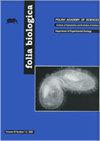Study of the diets of two coexisting species – invasive Chinese sleeper (Perccottus glenii Dybowski, 1877) and native European perch (Perca fluviatilis Linnaeus, 1758)
IF 0.8
4区 生物学
Q4 BIOLOGY
引用次数: 0
Abstract
In Poland, the Chinese sleeper Perccottus glenii is one of the alien fish species which, by effectively competing with native species, may contribute to the weakening of their population and a reduction of the biodiversity. The aim of this paper is to study the diets of two coexisting species: the native European perch Perca fluviatilis and the invasive Chinese sleeper. The fish were collected from a watercourse used for draining water from a fishing farm, located in the Nida River water system (Poland), using the electrofishing method. The captured fish were killed, preserved in a 4% formaldehyde solution and the stomachs of the fish were dissected. Then, based on the materials collected from these stomachs, the abundance and taxonomic rankings of the individual diet components (quantity of individuals in the individual taxa) were determined. The overlap of the P. fluviatilis and P. glenii feeding spectra was studied using a principal component analysis (PCA). The analysis of the data collected demonstrated that the diets of these two species overlaps considerably. At the same time, the analysis of the major diet components showed that the niche used by P. fluviatilis is broader than that used by P. glenii. It seems that, due to its high level of plasticity, P. fluviatilis is able to withstand the pressures of P. glenii and is also able to limit its abundance. Both species frequently choose fish as their prey, including juvenile common carp Cyprinus carpio Linnaeus, 1758, which indicates that together with native predators, P. glenii may pose a considerable threat to farmed juvenile Cyprinidae.两种共存物种——入侵中国鲈鱼(Perccottus glenii Dybowski, 1877)和欧洲本土鲈鱼(Perca fluviatilis Linnaeus, 1758)的饮食研究
在波兰,中国枕鱼是外来鱼种之一,由于与本地鱼种的有效竞争,可能导致其种群的削弱和生物多样性的减少。本文旨在研究两种共存物种:欧洲本土鲈鱼(pera fluviatilis)和中国入侵鲈(Chinese sleeper)的饮食。这些鱼是从位于Nida河水系(波兰)的一个渔场用于排水的水道中收集的,使用电钓法。捕获的鱼被杀死,保存在4%的甲醛溶液中,鱼的胃被解剖。然后,根据收集到的胃材料,确定个体饲料成分的丰度和分类等级(个体在个体分类群中的数量)。采用主成分分析(PCA)方法,研究了河滨扁扁鱼和glenii扁扁鱼取食光谱的重叠。对收集到的数据的分析表明,这两个物种的饮食有很大的重叠。同时,对主要食料成分的分析表明,河流假单胞菌所利用的生态位比glenii假单胞菌所利用的生态位更广。似乎,由于其高水平的可塑性,P. fluviatilis能够承受P. glenii的压力,也能够限制其丰度。这两种鱼类都经常选择鱼类作为猎物,包括鲤鱼幼鱼Cyprinus carpio Linnaeus, 1758,这表明,与本地捕食者一起,P. glenii可能对养殖的鲤鱼幼鱼构成相当大的威胁。
本文章由计算机程序翻译,如有差异,请以英文原文为准。
求助全文
约1分钟内获得全文
求助全文
来源期刊

Folia Biologica-Krakow
医学-生物学
CiteScore
1.10
自引率
14.30%
发文量
15
审稿时长
>12 weeks
期刊介绍:
Folia Biologica (Kraków) is an international online open access journal accepting original scientific articles on various aspects of zoology: phylogeny, genetics, chromosomal studies, ecology, biogeography, experimental zoology and ultrastructural studies. The language of publication is English, articles are assembled in four issues per year.
 求助内容:
求助内容: 应助结果提醒方式:
应助结果提醒方式:


